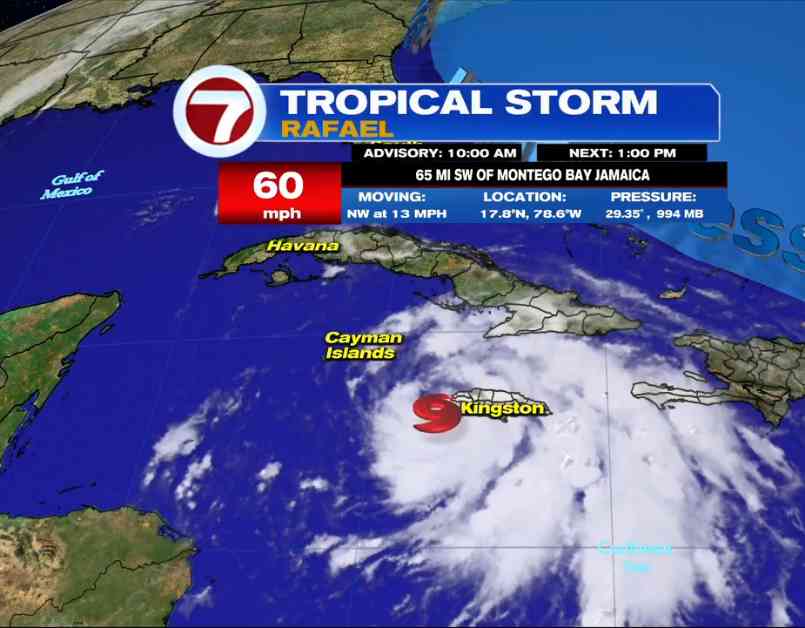Tropical Storm Rafael has now strengthened into a Category 1 hurricane as it moves past the Cayman Islands and heads towards western Cuba. This is not good news for Cuba, which is still recovering from a previous hurricane that caused significant damage and fatalities.
The hurricane, with maximum sustained winds of 75 mph, is expected to make landfall in Cuba on Wednesday after bringing heavy rain to Jamaica and the Cayman Islands. The National Hurricane Center has issued warnings for floods, storm surges, and mudslides in the affected areas.
In response to the approaching storm, the U.S. State Department has advised non-essential staff and American citizens to consider leaving Cuba. The Cuban Civil Defense has also urged residents to prepare for the impact of the hurricane and to stay in a safe location once the storm hits.
Schools and government offices in the Cayman Islands have been closed, and residents have been urged to make necessary preparations. Heavy rainfall is expected in the western Caribbean, leading to potential flooding and mudslides in Cuba and the Cayman Islands.
The impact of Hurricane Rafael is not limited to Cuba and the Cayman Islands. Forecasters predict heavy rainfall and possible storm surges in Florida and other parts of the southeastern U.S. later in the week. Tornadoes are also expected in the Keys and southwestern Florida on Wednesday.
This hurricane season has been particularly active, with Rafael being the 17th named storm so far. The National Oceanic and Atmospheric Administration has predicted that the 2024 hurricane season will see between 17 and 25 named storms, with as many as 13 hurricanes and four major hurricanes.
As the hurricane approaches, it is important for residents in the affected areas to follow safety guidelines and be prepared for potential impacts. Stay informed through local news sources and official weather updates to ensure your safety during this challenging time.
Can You Wear Jewelry During Sports? A Guide to Staying Safe and Stylish
Jewelry is a powerful form of self-expression, but it can pose challenges during sports activities. For those who love pieces like the iconic Ajda Bilezik or unique Ajda Bilezik Modelleri, understanding how to incorporate them into an active lifestyle is essential. Let’s explore the dos and don’ts of wearing jewelry during sports while maintaining both style and safety.
1. Why Jewelry Choices Matter During Sports
Wearing jewelry while exercising or playing sports requires careful consideration. Pieces like bracelets, necklaces, or rings can easily get caught in equipment, leading to injuries or damage to the jewelry.
For example, an Ajda Bilezik, known for its intricate craftsmanship, might be too delicate or bulky for high-intensity activities. Contact sports like basketball or rugby require players to remove jewelry entirely to prevent harm. However, for low-impact activities like yoga or walking, lighter and more secure pieces can be appropriate.
Choosing the right jewelry is key to protecting both yourself and your valuables.
2. What Type of Jewelry Works Best for Active Lifestyles?
If you can’t part with your jewelry during workouts, opt for designs that are:
- Minimalist: Slim and lightweight pieces are less likely to interfere with movement.
- Durable: Materials like stainless steel, titanium, or platinum can withstand sweat and physical impact.
- Secure: Opt for snug fits or pieces with strong clasps to avoid losing them during activities.
Ajda Bilezik modelleri often include contemporary designs that balance elegance and practicality. These modern styles are perfect for those looking to blend tradition with an active lifestyle, especially for low-intensity sports.
3. Sports and Jewelry: Safety Tips You Should Know
Staying safe while wearing jewelry during sports requires a bit of forethought. Follow these tips to ensure comfort and security:
- Remove for High-Impact Activities: For sports like soccer, basketball, or swimming, it’s best to avoid wearing any jewelry to prevent accidents.
- Stick to Essentials: If you must wear something, choose a single, lightweight piece like a thin bracelet or stud earrings.
- Use Sweat-Resistant Materials: Sweat can tarnish certain metals, so opt for non-corrosive materials like gold or silicone.
- Secure Your Jewelry: Double-check that clasps and fastenings are tight. Pieces like Ajda Bilezik modelleri often come with secure closures, making them a safe choice for light activities.
4. Incorporating Ajda Bilezik into Your Active Life
Ajda Bilezik, a symbol of elegance and cultural heritage, might not be the first thing you think of for sportswear. However, modern Ajda Bilezik modelleri are designed with versatility in mind.
These updated designs feature sleeker and lighter structures, making them suitable for daily wear and even some sports. For example:
- A slim, smooth-edged Ajda Bilezik works well for activities like yoga or walking.
- Avoid wearing heavier or intricate models during workouts to prevent discomfort or damage.
By selecting the right model, you can carry a touch of tradition into your active routines.
5. Caring for Your Jewelry After Sports
Even the best materials can suffer from exposure to sweat, moisture, or dirt during sports. Proper care is essential to maintaining the shine and quality of your jewelry.
- Clean Regularly: Use a soft cloth to wipe away sweat and grime after each use.
- Store Properly: Keep your jewelry in a dry, padded case to prevent scratches.
- Inspect Frequently: Check for loose clasps, stones, or signs of wear. This is especially important for intricate pieces like Ajda Bilezik.
- Avoid Prolonged Exposure: Don’t leave your jewelry exposed to harsh chemicals like chlorine or salt water.
Conclusion
Wearing jewelry during sports is possible with the right approach. Whether you’re drawn to the timeless beauty of Ajda Bilezik or exploring modern Ajda Bilezik modelleri, choosing safe, secure, and durable options ensures both style and functionality. With careful planning and maintenance, you can embrace your active lifestyle without compromising on elegance.


